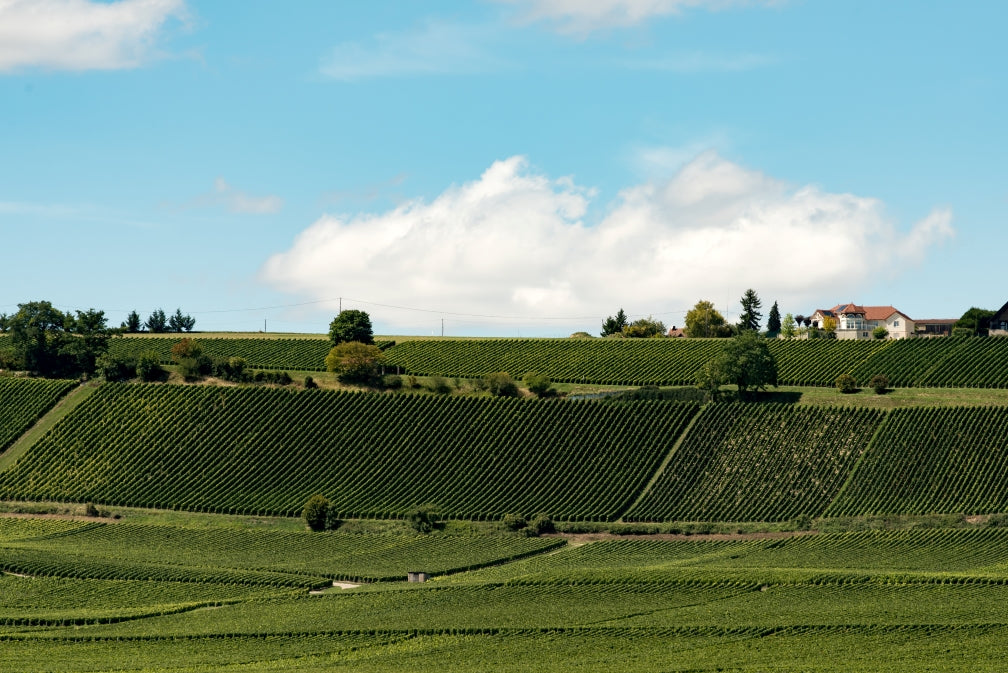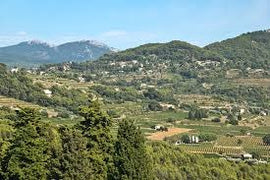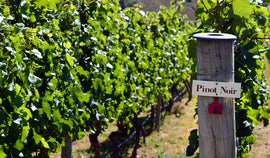Côte des Bar
From north to south, Champagne's kingdom comprises 5 fiefs - Montagne de Reims, Vallée de la Marne, Côte des Blancs, Côte de Sézanne and Côte des Bar - united under the crown that is the AOC Champagne appellation, one of the most prestigious in the wine world. From a distance it seems very much like an all-for-one, one-for-all, round table type situation, but one of those sub-regions has always been regarded as at best last among equals, kiddie table material, and at worst completely unwelcome. Champagne may be an unlikely place to find a rebel, but in the grand tradition of underdogs everywhere, the Côte des Bar has embraced its perceived weaknesses as strengths, armored itself in iconoclasm and is producing excellent, original and relatively affordable bubbly. This month we are featuring two of our favorites.
Most Champagne regions are within the Marne département, by Reims and Épernay. The Côte des Bar is the only major region in the Aube, southeast of the city of Troyes, meaning it is closer by car to Chablis in Burgundy than Reims. Accordingly, the landscape is nothing like central Champagne; vineyards here are leisurely interspersed with forests, farms, and streams, unlike the densely-planted Montagne de Reims, Côte des Blancs, and Vallée de la Marne. The soil is also closer to that of Chablis — Kimmeridgian marl topped by Portlandian (Tithonian) limestone — than that of the north, which is mostly Cretaceous chalk.
Over the years these differences have been the source of conflict between the Côte des Bar and the rest of Champagne. Until the French Revolution, the former was officially part of Burgundy, and in the early 20th century, following phylloxera, this fact was used as a pretext by the powerful Marnais Winegrowers Union to try to exclude growers from the Aube (the larger region containing the Côte des Bar wine region) from Champagne’s borders. This in part provoked the famous winegrowers revolt, when more than 3,000 soldiers were sent to Bar-sur-Seine to calm the fury of the winegrowers and the general population of surrounding villages.
A compromise of sorts was attempted when the official boundaries of the AOC were being drawn in 1911, with Aube regions being classified as Champagne deuxième zone, literally constituting a 2nd tier. However, even this cleavage proved too close an association for growers in the Marne, and they rioted and burned vineyards, dumped wine and destroyed cellars to prevent the new classification from taking effect. Eventually, the Côte des Bar was fully incorporated into Champagne in 1927, but it is still the only sub-region with no grand or premier cru villages.
Nevertheless the Côte des Bar is arguably Champagne’s most exciting spot at the moment, thanks in large part to grower-producers like Vincent Couche, the first vigneron ever in the entire appellation to achieve Demeter certified biodynamic status for his vineyards (only 2% of production in Champagne is even organic.) Like most producers in the area, he works mostly with Pinot Noir. Despite the Côte des Bar’s proximity to Chablis, humid Atlantic influences coming from the west and continental influences with higher temperatures help Pinot Noir ripen extremely well in the area. Our other producer this month, Guy De Forez, is a pioneer in sustainable winemaking in Les Riceys, a 17th century village in the Côte des Bar famed for its Brut Rose, which is 100% Pinot Noir, and which we are featuring here.
|
Vincent Couche Elegance NV |
|
|
From: Aube, Champagne |
About the Winemaker: For Vincent Couche, the distance from traditional power centers has been a fount of freedom to make champagne as he sees fit. Vincent comes from a third generation winemaking family, but does not highlight or dwell on the family’s past, preferring to highlight the work the domaine is doing now. Vincent took over the Domaine in 1999 and began a wholesale restructuring of farming and cellar work. He first began by replanting his vineyard under the direction of terroir specialist Claude Bourguignon. While that name may not mean much in champagne, over the years Claude has done work for a who’s who of iconic french properties and producers mostly in burgundy: domaine Romanee Conti, Dujac, Leflaive, Selosse, Dagueneau, and Chave. The Couche family owns 32 acres of vines split between two different terroirs: there are 7 acres of Chardonnay vines in Montgueux (with chalky soils similar to Chablis) and 25 acres of mostly Pinot Noir in Buxeuil where the parcels mostly face south and west on steep slopes overlooking the Seine river. The overarching philosophy that Vincent follows is right there on the front label: his is a biodynamic production. This embrace of biodynamics has been there since the start in 1999, but certification takes time, and it wasn’t until 2008 that the domaine and the cellars were certified biodynamic. In fact, in spite of the extended timeline of the process, Vincent’s cellar and fields in combination were the first to receive Demeter certification in all of Champagne. Simply put, Vincent is obsessed with his vines and the healthy soils they grow in, and is dedicated to making wines in the cellar without any additions. At harvest time Vincent and his family pick the grapes by taste and touch, and generally harvest over a week after his neighbors in both villages. Because Vincent won’t add sugar to the wines, his grapes need higher sugar levels and higher levels of ripeness than is the norm. In the cool deep cellar wines are fermented and aged in oak and stainless steel without added yeast or nutrients and the wines don’t see any additions. Assemblage/Vinification: 70% Pinot Noir/30% Chardonnay Soil is Kimmeridgian for the Pinot Noir from BuxeuiI & Cretacious (Clay and Silex) from Montgueux for the Chardonnay. Aged 1 year in barrel, 2 years on the lees in bottle before disgorging. Unfiined and unfiltered. No added SO2. Dosage: Brut Nature - 0g/liter
Tasting Notes: Vibrant and high-acid, yet rich and round on the palate, this biodynamic champagne has something for everyone. Champagne drinkers will love the crunchy pear, raspberry, and golden delicious apple fruit, the kiss of brioche (from all the time on the lees), and the long, minerally finish |
|
Winemaker: Vincent Couche |
|
|
Price per bottle / Price per case: $70.99 / $766.69 |
|
|
Suggested Food Pairing: Fresh oysters, Aged Comte Cheese, Fondant Potatoes, Chilled lobster tails with green goddess aioli. |
|
|
Guy De Forez Brut Rosé NV |
|
|
From: Riceys, Aube, Champagne |
About the Winemaking: Champagne producer Guy de Forez is housed in a beautiful building built in the 17th century in the town of Les Riceys. Francis Wenner and his wife Sylvie farm 12 acres of mostly Pinot Noir with small amounts of Chardonnay and Pinot Meunier. The house was one of the early pioneers of farming sustainably in the region, and are currently participating members of the Terra Vitis federation. The town of Les Riceys is also traditionally known for making beautiful still rose wine which ages beautifully. The range of Champagnes are full bodied with a purity and precise freshness that make these wines ideal dinner companions. Assemblage/Vinification: 100% Pinot Noir from Limestone & Clay soils. Fermentation & Elevage in Stainless Steel. 70% of 2 day semi-carbonic maceration of Pinot Noir – 30% direct to press Pinot Noir. Dosage: 11g/liter Tasting Notes: Great definition and cut to this Rosé exploding on the palate with waves of red fruits. Powerful and focused Champagne with great energy that makes it versatile at the table. |
|
Winemaker: Francis & Sylvie Wenner |
|
|
Price per bottle / Price per case: $55.99 / $604.69 |
|
|
Suggested Food Pairing: Smoked salmon canapes, mushroom and cheese quiche, Pigeon breast with roasted leeks and wild mushrooms, spicy shrimp linguini. |
|





